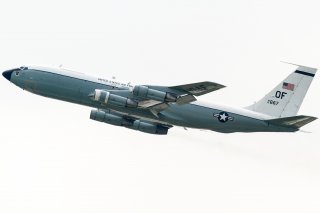America’s New Sniffer-Plane Would Track Rogue Nuclear Weapons
The U.S. Air Force is getting new reconnaissance planes equipped to detect atomic explosions.
The U.S. Air Force is getting new reconnaissance planes equipped to detect atomic explosions.
Well, the planes themselves aren’t exactly new. In fact, they’re 1960s-vintage aerial refuelers. But they’re more modern than are the Air Force’s existing nuke-sniffing recce aircraft. And they could revitalize an important mission as the world races to rearm with new atomic weapons.
The three WC-135Rs, based on the airframes of three former U.S. Air National Guard KC-135R tankers, are slated to replace two WC-135C/Ws that fly from Offutt Air Force Base in Nebraska.
The $220-million conversion effort should be complete by 2022.
The WC-135s are “bug-catchers,” to borrow Air Force slang. They carry air filters connected to sensors that can detect the radioactive particles that result from nuclear blasts. The WC-135s complement seismic sensors and other methods that help the U.S. government to track atomic tests.
The WC-135C/Ws entered service starting in 1965, replacing 1950s-vintage WB-50s. The current WC-135s are powered by older J57 engines, while the newer WC-135Rs sport CFM56 engines that are cleaner, more efficient and more powerful than are the J57s.
The WC-135Rs also will feature modern cockpits and better communications and navigation gear compared to the WC-135C/Ws. Despite their basic airframes dating back to the 1960s, the WC-135Rs are structurally sound and could continue flying for decades.
They might stay busy.
Various nuclear-test-ban treaties bar member countries such as the United States, Russia, the United Kingdom, France and China from conducting above-ground tests. But underground tests still are legal and, in any event, “rogue” states such as North Korea have not signed on to the test-ban treaties.
When North Korea in 2006 conducted its first-ever atomic test, an underground blast equivalent to roughly one kiloton of high-explosive, a WC-135 flying from Japan quickly detected radioactive dust from the test.
WC-135s since have been regular visitors to the Korean Peninsula as North Korea continues to build up its nuclear arsenal.
The Air Force’s effort to replace the older WC-135s surely is a welcome initiative at Offutt Air Force Base, which operates many of the flying branch’s oldest but most important reconnaissance aircraft.
Offutt is also awaiting replacements for its two aging OC-135s, which fly photographic inspection missions over Russia in order to verify compliance with arms-control treaties. Those missions take place under the auspices of the 1992 Open Skies Treaty.
The Air Force has secured funding for new Open Skies planes based on business jets. But the administration of Pres. Donald Trump has signalled it might cancel Open Skies, based on the administration’s false belief that the treaty allows Russia to spy on the United States.
The Pentagon has declined to cut a contract for the new Open Skies planes until Trump decides whether to pull out of the treaty.
David Axe is defense editor at The National Interest. He is the author of the graphic novels War Fix, War Is Boring and Machete Squad.

